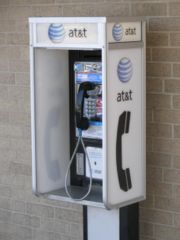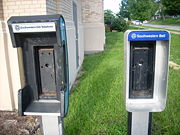AT&T
2008/9 Schools Wikipedia Selection. Related subjects: Companies
| AT&T Inc. | |
|---|---|
 |
|
| Type | Public ( NYSE: T) |
| Founded | 1983 |
| Headquarters | |
| Area served | Worldwide |
| Key people | Randall L. Stephenson ( Chairman), ( CEO) & ( President) |
| Industry | Telecommunications |
| Products | Wireless Telephone Internet Television |
| Market Cap | USD $278.199 Billion (2007) |
| Revenue | ▲ USD 118.928 Billion (2007) |
| Operating income | ▲ USD 20.404 Billion (2007) |
| Net income | ▲ USD $11.951 Billion (2007) |
| Total assets | ▲ USD $275.644 Billion (2007) |
| Total equity | ▲ USD $115.367 Billion (2007) |
| Employees | 310,070 (2008) |
| Website | www.att.com |
AT&T Inc. ( NYSE: T) is the largest provider of both local and long distance telephone services, wireless service, and DSL Internet access in the United States with 71.4 million customers. In 2005, "Baby Bell" SBC Communications Inc. purchased former "Ma Bell" AT&T Corporation and then changed the name of the company after the merger to the more iconic AT&T moniker and the T stock-trading symbol (for "telephone").
The current AT&T includes eleven of the original Bell Operating Companies, and the original long distance division. While it reconstitutes much of the former Bell System, AT&T Inc. lacks the vertical integration of the historic AT&T Corp. which prompted the antitrust suit and breakup in 1984.
The company was honored at the 2008 Technology & Engineering Emmy Awards for development of coaxial cable technology.
History
Founding, expansion
AT&T Inc. was founded in 1983 as Southwestern Bell Corporation, headquartered in St. Louis, Missouri. It was one of the seven original Regional Bell Operating Companies, or "Baby Bells". The company — a holding company for Southwestern Bell Telephone Company — was created as a result of U.S. antitrust action against American Telephone & Telegraph Company in 1983. It took full control of Southwestern Bell Telephone on January 1, 1984.
In 1993, Southwestern Bell Corp. moved its headquarters to San Antonio, Texas, and, during its annual meeting of stockholders in 1995, the company announced that its name would be changed to SBC Communications, Inc. The name change was an effort to reinforce the company's national and global reach and the company stated not only that "SBC" was not an acronym for Southwestern Bell Corporation but also that it did not stand for anything at all.
SBC then proceeded (as permitted by the Telecommunications Act of 1996) to acquire fellow Baby Bell Pacific Telesis, the Regional Bell operating company serving Nevada and California, in 1997 and the former independent Bell System franchise SNET (Southern New England Telephone).
SBC then announced plans to acquire Ameritech, the Regional Bell operating company serving Illinois, Indiana, Michigan, Ohio, and Wisconsin, and told the FCC that it would allow competitors access to local markets where it had had a monopoly if the FCC would allow them to acquire Ameritech. The FCC agreed and in May 1998, SBC and Ameritech announced the merger would move forward. After making several organizational changes (such as the sale of Ameritech Wireless to GTE) to satisfy state and Federal regulators, the two merged on October 8, 1999. The FCC later fined SBC Communications $6 million for failure to comply with agreements made in order to secure approval of the merger.
On November 1, 1999, SBC became a part of the Dow Jones Industrial Average.
In 2002, SBC ended marketing its operating companies under different names, and simply opted to give its companies different doing business as names based on the state (a practice already in use by Ameritech since 1993), and it gave the holding companies it had purchased d/b/a names based on their general region.
AT&T Corporation acquisition

On January 31, 2005, SBC announced that it would purchase AT&T Corp. for more than $16 billion. The announcement came almost 8 years after SBC and AT&T called off their first merger talks and nearly a year after initial merger talks between AT&T and BellSouth fell apart. AT&T stockholders, meeting in Denver, approved the merger on June 30, 2005. The U.S. Department of Justice cleared the merger on October 27, 2005, and the Federal Communications Commission approved it on October 31, 2005. The merger was finalized on November 18, 2005. SBC changed its corporate name to AT&T Inc., and updated the former AT&T's graphic logo, however the existing AT&T Sound trademark (voiced by Pat Fleet) continues to be used.
On December 1, 2005 the combined company began trading under the historic "T" stock ticker symbol on the NYSE. To differentiate from the preceding company, AT&T is formally known as "AT&T Inc.", while the preceding company was "AT&T Corp."
BellSouth acquisition
On Friday December 29, 2006, the Federal Communications Commission (FCC) approved the acquisition of BellSouth valued at approximately $86 billion (or 1.325 shares of AT&T for each share of BellSouth at the close of trading December 29, 2006). The new combined company retained the name AT&T. The deal consolidated ownership of both Cingular Wireless and Yellowpages.com, once joint ventures between BellSouth and AT&T. All services, including wireless, are currently offered under the AT&T name.
Bell Operating Companies
Of the twenty-two Bell Operating Companies which AT&T owned prior to the 1984 agreement to divest, eleven (BellSouth Telecommunications combines two former BOCs) have become a part of the new AT&T Inc. with the completion of their acquisition of BellSouth Corporation on December 29, 2006:
- BellSouth Telecommunications (formerly known as Southern Bell and South Central Bell)
- Illinois Bell
- Indiana Bell
- Michigan Bell
- Nevada Bell (formerly known as Bell Telephone Company of Nevada)
- Ohio Bell
- Pacific Bell (formerly Pacific Telephone & Telegraph)
- Southwestern Bell
- Wisconsin Bell (formerly Wisconsin Telephone)
AT&T owns the following operating companies not considered a Bell Operating Company:
- Southern New England Telephone — Now wholly owned, the original AT&T held 16.8% interest prior to 1984.
Former operating companies
The following companies have gone to defunct status under SBC/AT&T ownership:
- Southwestern Bell Texas - a separate operating company created by SBC and merged back into SWBT on December 30, 2001.
- Woodbury Telephone - merged into Southern New England Telephone on June 1, 2007.
Corporate governance
AT&T's current board mainly consists of members of SBC's board of directors.
- Randall L. Stephenson — Chairman and Chief Executive Officer
- James A. Henderson
- Gilbert F. Amelio
- William F. Aldinger III
- August A. Busch III
- Martin K. Eby, Jr.
- Charles F. Knight
- Jon C. Madonna
- Lynn M. Martin
- Ronald M. Crump
- John B. McCoy
- Mary S. Metz
- Toni Rembe
- S. Donley Ritchey
- Joyce M. Roche
- Laura D'Andrea Tyson
- Patricia P. Upton
Contributions to political campaigns
According to the Centre for Responsive Politics, AT&T is the United States' second largest donor to political campaigns, having contributed more than US$ 36 million since 1990, 56% and 44% of which went to Republican and Democratic recipients, respectively. A key political issue for AT&T is the question of which businesses win the right to profit by providing broadband internet access in the United States.
In 2005, AT&T was among 53 entities that contributed the maximum of $250,000 to the second inauguration of President George W. Bush.
Censorship controversy
In August 2007, the band Pearl Jam performed in Chicago at Lollapalooza which was being web-broadcast by AT&T. The band, while playing the song "Daughter", started playing a version of Pink Floyd's " Another Brick in the Wall" but with altered lyrics critical of president George Bush. These lyrics included "George Bush, leave this world alone!" and, "George Bush, find yourself another home!". Listeners to AT&T's web broadcast heard only the first line because the rest was censored although, AT&T spokesman Michael Coe said that the silencing was "a mistake."
In September 2007, AT&T changed their legal policy to state that "AT&T may immediately terminate or suspend all or a portion of your Service, any Member ID, electronic mail address, IP address, Universal Resource Locator or domain name used by you, without notice for conduct that AT&T believes"..."(c) tends to damage the name or reputation of AT&T, or its parents, affiliates and subsidiaries." By October 10, 2007 AT&T had altered the terms and conditions for its Internet service to explicitly support freedom of expression by its subscribers, after an outcry claiming the company had given itself the right to censor its subscribers' transmissions.
Section 5.1 of AT&T's new terms of service now reads "AT&T respects freedom of expression and believes it is a foundation of our free society to express differing points of view. AT&T will not terminate, disconnect or suspend service because of the views you or we express on public policy matters, political issues or political campaigns."
Privacy controversy
In 2006, the Electronic Frontier Foundation lodged a class action lawsuit, Hepting v. AT&T, which alleged that AT&T had allowed agents of the National Security Agency (NSA) to monitor phone and Internet communications of AT&T customers without warrants. If true, this would violate the Foreign Intelligence Surveillance Act of 1978 and the First and Fourth Amendments of the U.S. Constitution. AT&T has yet to confirm or deny that monitoring by the NSA is occurring. In April 2006, a retired former AT&T technician, Mark Klein, lodged an affidavit supporting this allegation. The Department of Justice has stated they will intervene in this lawsuit by means of State Secrets Privilege.
In May 2006, USA Today reported that all international and domestic calling records had been handed over to the National Security Agency by AT&T, Verizon, SBC, and BellSouth for the purpose of creating a massive calling database. The portions of the new AT&T that had been part of SBC Communications before November 18, 2005 were not mentioned.
On June 21, 2006, the San Francisco Chronicle reported that AT&T had rewritten rules on their privacy policy. The policy, which took effect June 23, 2006, says that "AT&T — not customers — owns customers' confidential info and can use it 'to protect its legitimate business interests, safeguard others, or respond to legal process.' "
On August 22, 2007, National Intelligence Director Mike McConnell confirmed that AT&T was one of the telecommunications companies that assisted with the government's warrantless wire-tapping program on calls between foreign and domestic sources.
On November 8, 2007, Mark Klein, a former AT&T technician, told Keith Olbermann of MSNBC that all Internet traffic passing over AT&T lines was copied into a locked room at the company's San Francisco office — to which only employees with National Security Agency clearance had access.
Payphone removal
On December 3, 2007, AT&T announced it would remove all of its 65,000 remaining payphones by the end of 2008. BellSouth already had removed its payphones years before being acquired by AT&T, and Qwest sold its pay telephone services in 2004. Verizon Communications will be the only Baby Bell that will continue to operate pay telephones following the removal of AT&T pay telephones, and currently has no interest in leaving the business.
Intellectual property filtering
In January 2008, the company reported plans to begin filtering all Internet traffic which passes through its network for intellectual property violations.
Commentators in the media have speculated that if this plan is implemented, it would lead to a mass exodus of subscribers leaving AT&T, although this is misleading as internet traffic may go through the company's network anyway.


